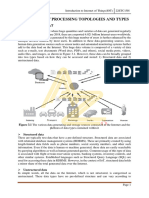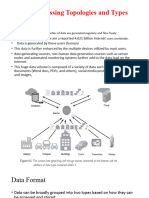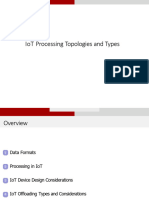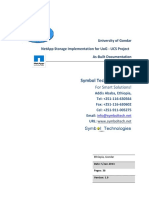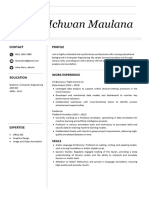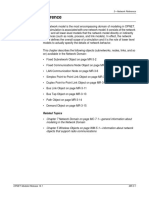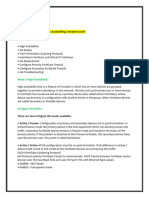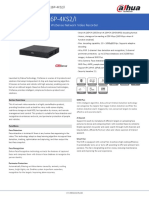INTERNET OF THINGS [21CS735]
MODULE –3
SYLLABUS
IoT Processing Topologies and Types: Data Format, Importance of Processing in IoT,
Processing Topologies, IoT Device Design and Selection Considerations, Processing
Offloading.
Textbook 1: Chapter 6 – 6.1 to 6.5
SESSION - 1
3.1 Data Format
• The Internet is a vast space where huge quantities and varieties of
data are generated regularly and flow freely.
• In addition to these data-generating sources, non-human data
generation sources such as sensor nodes and automated monitoring
systems further add to the data load on the Internet.
• This huge data volume is composed of a variety of data such as e-
mails, text documents (Word docs, PDFs, and others), social media
posts, videos, audio files, and images.
Figure 3.1 below shows the various data generating and storage sources
connected to the Internet and the plethora of data types contained within
it.
1
� INTERNET OF THINGS [21CS735]
Figure 3.1: Various data generating and storage sources
3.1.1 Structured data
• Text data that have a pre-defined structure. Structured data are
associated with relational database management systems
(RDBMS).
• Primarily created by using length-limited data fields such as phone
numbers, social security numbers, and other such information.
• Even if the data is human or machine generated, these data are
easily searchable by querying algorithms as well as human
generated queries.
• Common usage of this type of data is associated with flight or
train reservation systems, banking systems, inventory controls, and
other similar systems.
• Structured Query Language (SQL) is used for accessing these data
in RDBMS.
3.1.2 Unstructured data
• All the data on the Internet, which is not structured, is categorized
as unstructured.
• These data types have no pre-defined structure and can vary
according to applications and data-generating sources.
2
� INTERNET OF THINGS [21CS735]
• Examples of human-generated unstructured data include text, e-
mails, videos, images, phone recordings, chats, and others.
• Examples of machine-generated unstructured data include sensor
data from traffic, buildings, industries, satellite imagery,
surveillance videos, and others.
• This data type does not have fixed formats associated with it,
which makes it very difficult for querying algorithms to perform a
look-up.
• Querying languages such as NoSQL are generally used for this
data type.
Review Questions
1 List any two non-human data generation sources.
2 List any three data generation sources.
3 What is structured data? Give example.
4 What is unstructured data? Give example.
5 Which language is used for accessing structured data?
3
� INTERNET OF THINGS [21CS735]
SESSION - 2
3.2. Importance of Processing in IoT
First divide the data to be processed into three types based on the
urgency of processing:
1) Very time critical
• Data from sources such as flight control systems, healthcare, and
other such sources, which need immediate decision support, are
deemed as very critical.
• These data have a very low threshold of processing latency,
typically in the range of a few milliseconds.
2) Time critical
• Data from sources that can tolerate normal processing latency.
• These data, generally associated with sources such as vehicles,
traffic, machine systems, smart home systems, surveillance
systems.
3) Normal
• Can tolerate a processing latency of a few minutes to a few hours
and are typically associated with less data-sensitive domains such
as agriculture, environmental monitoring, and others.
• The processing requirements of data from very time-critical
sources are exceptionally high.
• Here, the need for processing the data in place or almost nearer to
the source is crucial in achieving the deployment success of such
domains.
• The requirements of processing from category 2 data sources
(time-critical), the processing requirements allow for the
transmission of data to be processed to remote locations/processors
such as clouds or through collaborative processing.
• The last category of data sources (normal) typically have no
particular time requirements for processing urgently and are
pursued leisurely as such.
4
� INTERNET OF THINGS [21CS735]
3.3 Processing Topologies
• We can divide the various processing solutions into two large
topologies: 1) On-site 2) Off-site.
The off-site processing topology can be further divided into the
following:
1) Remote processing
2) Collaborative processing
3.3.1 On-site processing
• The on-site processing topology signifies that the data is processed
at the source itself. Very low tolerance for latencies.
• These latencies may result from the processing hardware or the
network.
• Healthcare and flight control systems (real-time systems) have a
breakneck data generation rate.
• Figure 3.2 shows the on-site processing topology, an event (here,
fire) is detected utilizing a temperature sensor connected to a
sensor node.
Figure 3.2: Event detection using an on-site processing topology
5
� INTERNET OF THINGS [21CS735]
The sensor node processes the information from the sensed event and
generates an alert. The node additionally has the option of forwarding
the data to a remote infrastructure for further analysis and storage.
Review Questions
1 List the types of data processing in IoT.
2 Give two examples for very time critical systems.
3 Give two examples for time critical systems.
4 Give two examples for normal systems.
5 List types of processing topologies.
6
� INTERNET OF THINGS [21CS735]
SESSION - 3
3.3.2 Off-site processing
Cheaper-low demands and requirements of processing at the source itself.
Sensor node is responsible for the collection and framing of data that is
eventually to be transmitted to another location for processing.
Off-site topology has a few dedicated high-processing enabled devices,
which can be borrowed by multiple simpler sensor nodes to accomplish
their tasks. In the off-site topology, the data from these sensor nodes is
transmitted either to a remote location or to multiple processing nodes.
1) Remote processing
Sensing of data by various sensor nodes, the data is then forwarded to
a remote server or a cloud-based infrastructure for further processing.
The processing of data from hundreds and thousands of sensor nodes
can be simultaneously offloaded to a single, powerful computing
platform.
Massive cost and energy savings. Figure 3.3 shows event detection
using an off-site remote processing topology. Sensing of an event is
performed locally, and the decision making is outsourced to a remote
processor (here, cloud).
Figure 3.3: Event detection using an off-site remote processing topology
7
� INTERNET OF THINGS [21CS735]
2) Collaborative processing
Typically finds use in scenarios with limited or no network
connectivity, especially systems lacking a backbone network. Reduces
latencies due to the transfer of data over the network. It conserves
bandwidth of the network, especially ones connecting to the Internet.
This topology can be quite beneficial for applications such as
agriculture where an intense and temporally high frequency of data
processing is not required as agricultural data is generally logged after
significantly long intervals. Uses mesh networks for easy
implementation of this topology.
Figure 3.4: Event detection using collaborative processing topology
This paradigm tends to use up a lot of network bandwidth and relies
heavily on the presence of network connectivity between the sensor
nodes and the remote processing infrastructure.
8
� INTERNET OF THINGS [21CS735]
Review Questions
1 What is an off-site topology?
2 What is a remote processing?
3 Which are the two factors that off-site topology relies on?
4 What is collaborative processing?
5 Which topology is used for implementing collaborative
processing?
9
� INTERNET OF THINGS [21CS735]
SESSION - 4
3.4 IoT Device Design and Selection Considerations
1) Size: This is one of the crucial factors for deciding the form factor and the
energy consumption of a sensor node. It has been observed that larger the form
factor, larger is the energy consumption of the hardware. Large form factors are
not suitable for a significant bulk of IoT applications, which rely on minimal
form factor solutions.
2) Energy: The energy requirements of a processor is the most important
deciding factor in designing IoT-based sensing solutions. Higher the energy
requirements, higher is the energy source (battery) replacement frequency. This
principle automatically lowers the long-term sustainability of sensing hardware.
3) Cost: The cost of a processor, besides the cost of sensors, is the driving force
in deciding the intensity of deployment of sensor nodes for IoT-based solutions.
Cheaper cost of the hardware enables a much higher density of hardware
deployment by users of an IoT solution. Example: cheaper gas and fire detection
solutions would enable users to include much more sensing hardware for a
lesser cost.
4) Memory: The memory requirement of IoT devices determines the
capabilities the device can be armed with.Features such as local data processing,
data storage, data filtering, data formatting, and a host of other features rely
heavily on the memory capabilities of devices.
5) Processing power: Processing power is vital in deciding what type of
sensors can be accommodated with the IoT device/node, and what processing
features can integrate on-site with the IoT device.The processing power also
decides the type of applications the device can be associated with. Applications
that handle video and image data require IoT devices with higher processing
power as compared to applications requiring simple sensing of the environment.
6) I/O rating: The processor, is the deciding factor in determining the circuit
complexity, energy usage, and requirements for support of various sensing
solutions and sensor types. Newer processors have a meager I/O voltage rating
of 3.3 V as compared to 5V for older processors.
7) Add-ons: An IoT device provides, analog to digital conversion (ADC) units,
in-built clock circuits, connections to USB and ethernet, inbuilt wireless access
capabilities, and others helps in defining the robustness and usability of a
processor or IoT device in various application scenarios.
10
� INTERNET OF THINGS [21CS735]
-Add-ons also decides how fast a solution can be developed, especially the
hardware part of the whole IoT application.
Review Questions
1 Which are the crucial factors for deciding the form factor and the energy
consumption of a sensor node?
2 Which is the most important deciding factor in designing IoT-based
sensing solutions?
3 Which is the driving force in deciding the intensity of deployment of
sensor nodes for IoT-based solutions?
List two features used for determining memory capabilities of IoT
4 device.
5 Which factor is vital in deciding what type of sensors can be
accommodated with the IoT device?
11
� INTERNET OF THINGS [21CS735]
SESSION - 5
3.5 Processing Offloading
Figure 3.5 below shows the various data generating and storage sources
connected to the internet and the plethora of data types contained within it.
Figure 3.5: The various data generating and storage sources connected to the
Internet and the plethora of data types contained within it
• The processing offloading paradigm is important for the development of
densely deployable, energy-conserving, miniaturized, and cheap IoT-
based solutions for sensing tasks. The primary layer of sensing, we can
have multiple sensing types tasked with detecting an environment (fire,
surveillance, and others).
• The sensor enable these sensing types which are integrated with a
processor using wired or wireless connections (mostly, wired). For the
majority of IoT applications, the bulk of the processing is carried out
remotely in order to keep the on-site devices simple, small, and
economical.
• For off-site processing, data from the sensing layer can be forwarded to
the fog or cloud or can be contained within the edge layer.
12
� INTERNET OF THINGS [21CS735]
• The edge layer makes use of devices within the local network to process
data.
• The devices within the local network, till the fog, generally communicate
using short-range wireless connections.
• If the data needs to be sent further up the chain to the cloud, long-range
wireless connection enabling access to a backbone network is essential.
• Fog-based processing is still considered local because the fog nodes are
typically localized within a geographic area and serve the IoT nodes
within a much smaller coverage area as compared to the cloud.
• Fog nodes, which are at the level of gateways, may or may not be
accessed by the IoT devices through the internet.
• Finally, the approach of forwarding data to a cloud or a remote server, as
shown in the topology in Figure 3.5, requires the devices to be connected
to the Internet through long-range wireless/wired networks which
eventually connect to a backbone network.
• This approach is generally costly concerning network bandwidth, latency,
as well as the complexity of the devices and the network infrastructure
involved.
• Data offloading is divided into three parts: 1) offload location (which
outlines where all the processing can be offloaded in the IoT
architecture). 2) offload decision making (how to choose where to offload
the processing to and by how much). 3) offloading considerations
(deciding when to offload).
Review Questions
1 What is processing offloading?
2 Which is the primary layer of processing offloading paradigm?
3 List any two sensors used in sensing layer.
4 Which connections are used within local network?
5 Which nodes are at the level of gateways?
13
� INTERNET OF THINGS [21CS735]
SESSION – 6
3.5.1 Offload location: Offload location decides the applicability, cost, and
sustainability of the IoT application and deployment.
Offload location types
1) Edge: The data processing is facilitated to a location at or near the
source of data generation itself. Offloading to the edge is done to
achieve aggregation, manipulation, bandwidth reduction, and other
data operations directly on an IoT device.
2) Fog: Fog computing is a decentralized computing infrastructure that is
utilized to conserve network bandwidth, reduce latencies, restrict the
amount of data unnecessarily flowing through the Internet, and enable
rapid mobility support for IoT devices. The data, computing, storage
and applications are shifted to a place between the data source and the
cloud resulting in significantly reduced latencies and network
bandwidth usage.
3) Remote Server: A simple remote server with good processing power
may be used with IoT-based applications to offload the processing
from resource constrained IoT devices. Rapid scalability may be an
issue with remote servers. Costlier and hard to maintain compared to
cloud.
4) Cloud: Cloud computing is a configurable computer system, which
can get access to configurable resources, platforms, and high-level
services through a shared pool hosted remotely. A cloud is provisioned
for processing offloading so that processing resources can be rapidly
provisioned with minimal effort over the Internet, which can be
accessed globally.
Cloud enables massive scalability of solutions as they can enable
resource enhancement allocated to a user or solution in an on-demand
manner, without the user having to go through the pains of acquiring
and configuring new and costly hardware.
3.5.2 Offload decision making
• Where to offload and how much to offload is one of the major deciding
factors in the deployment of offsite processing topology based IoT
deployment. Some of the approach are as follows:
14
� INTERNET OF THINGS [21CS735]
1) Naive Approach: This approach is typically a hard approach, without too
much decision making. It can be considered as a rule-based approach in which
the data from IoT devices are offloaded to the nearest location based on the
achievement of certain offload criteria. Easy to implement, this approach is
never recommended, especially for dense deployments, or deployments where
the data generation rate is high or the data being offloaded in complex to handle
(multimedia or hybrid data types).Generally, statistical measures are consulted
for generating the rules for offload decision making.
2) Bargaining based approach: Bit processing-intensive during the decision
making stages, enables the alleviation of network traffic congestion enhances
service QoS parameters such as bandwidth, latencies, and others. Maximize
multiple parameters for the whole IoT implementation, in order to provide the
most optimal solution or QoS. Maximize the QoS by trying to reach a point
where the qualities of certain parameters are reduced, while the others are
enhanced. This measure is undertaken so that the achieved QoS is
collaboratively better for the full implementation rather than a select few
devices enjoying very high QoS. Example: Game theory.
Review Questions
1 Which decides the applicability, cost, and sustainability of the IoT
application and deployment?
2 List different offload location types.
3 What is edge processing?
4 List any two advantages of fog computing.
5 What is the issue faced by remote servers?
15
� INTERNET OF THINGS [21CS735]
SESSION – 7
3) Learning based approach: The learning based approaches generally rely
on past behavior and trends of data flow through the IoT architecture. The
memory requirements and processing requirements are high during the
decision making stages. Example: Machine learning.
3.5.3 Offloading considerations
There are a few offloading parameters which need to be considered while
deciding upon the offloading type to choose. These considerations typically
arise from the nature of the IoT application and the hardware being used to
interact with the application. Some of these parameters are as follows.
1) Bandwidth: The maximum amount of data that can be simultaneously
transmitted over the network between two points is the bandwidth of that
network. The bandwidth of a wired or wireless network is also considered
to be its data-carrying capacity and often used to describe the data rate of
that network.
2) Latency: It is the time delay incurred between the start and completion of
an operation. In the present context, latency can be due to the network
(network latency) or the processor (processing latency). In either case,
latency arises due to the physical limitations of the infrastructure, which is
associated with an operation. The operation can be data transfer over a
network or processing of a data at a processor.
3) Criticality: It defines the importance of a task being pursued by an IoT
application. The more critical a task is, the lesser latency is expected from
the IoT solution. For example, detection of fires using an IoT solution has
higher criticality than detection of agricultural field parameters. The former
requires a response time in the tune of milliseconds, whereas the latter can
be addressed within hours or even days.
4) Resources: It signifies the actual capabilities of an offload location. These
capabilities may be the processing power, the suite of analytical algorithms,
and others. For example, it is futile and wasteful to allocate processing
resources reserved for real-time multimedia processing (which are highly
energy-intensive and can process and analyze huge volumes of data in a
short duration) to scalar data (which can be addressed using nominal
resources without wasting much energy).
5) Data volume: The amount of data generated by a source or sources that
can be simultaneously handled by the offload location is referred to as its
data volume handling capacity. Typically, for large and dense IoT
16
� INTERNET OF THINGS [21CS735]
deployments, the offload location should be robust enough to address the
processing issues related to massive data volumes.
Review Questions
1 What is learning based approach?
2 Give example for learning based approach.
3 What is Bandwidth?
4 Define Latency.
5 Define Criticality.
********
17


